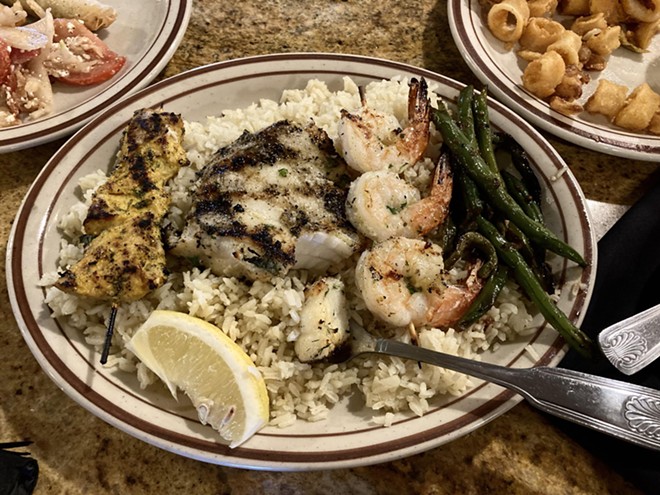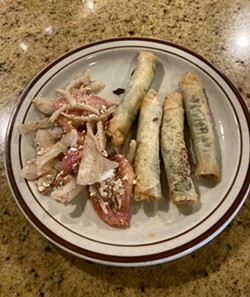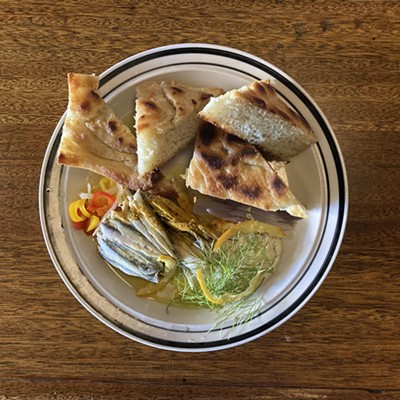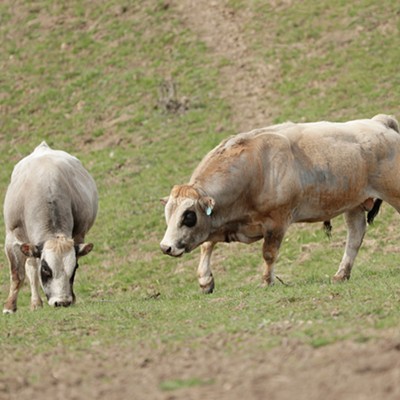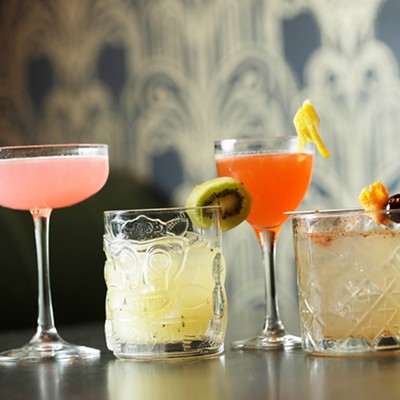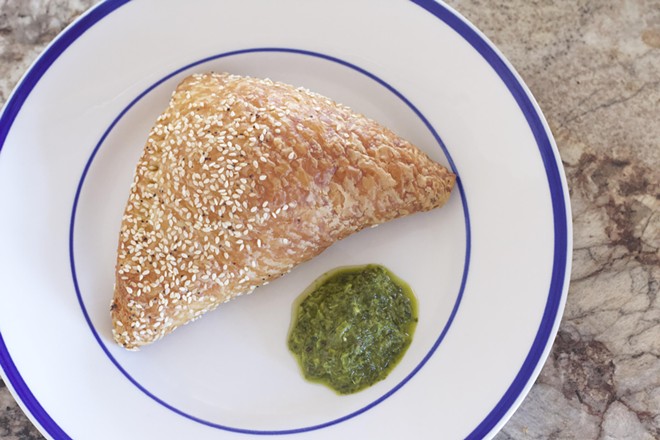
Count of dishes/places: 20
I set up an interview with Raci Erdem, owner of The White House Grill in Post Falls, over email. His response to my typical can-we-set-up-a-time-to-chat message was a quick one-liner: "Wednesday would work as long as you know what you're getting into!"
I wasn't quite sure what he meant. But I told him I didn't scare easy and made my way across the state line the following week.
I parked next to a white truck in the parking lot. As I got out, a tall, dark-haired man got out of the truck at the same time. I thought he looked familiar, but I didn't quite remember what Erdem looked like. I was planning on asking for the chef inside. But a moment of overconfidence took over.
"Hi! You're not Raci, are you?"
Dear reader, I don't know how familiar you are with Turkish, or how you would presume to pronounce Raci. I am not familiar with Turkish. I pronounced Raci like RAY-cee.
The startled stranger looked me dead in the face.
"Call me racy and I'm gonna have to fire you," he said.
I panicked. He laughed. It was Erdem, and it wasn't the first time he had been called "racy." But he quickly put the record straight. Raci is pronounced like RAH-ji, with a long "a" and no scandalous undertones.
What could've been a terrible introduction became instead an inside joke that kicked off one of the most fun interviews of my life. All thanks to Erdem, of course, who is hard to offend, laughs easily, and provided most of the jokes after my initial faux pas. The surprise of his generosity and hospitality doubled what would have already been a great interview.
Surprise can be wonderful. It can also be terrible. But it's always memorable.
As of this entry, we are a quarter of the way done with this Around the World project, and I have never been as surprised by food as I am by these three dishes. Two are unassuming plates at White House Grill. The third is a treat that I've eaten almost every Sunday without any clue of the cultural and geopolitical history it represents.
I can't do justice to the scope of these foods' histories and impacts here. But consider this an introduction, hopefully a good one, that starts a surprising experience of your own.
PATAGONIAN TOOTHFISH FROM THE SUBANTARCTIC
The Mixed Grill plate at White House Grill features curried chicken, tiger prawns and a luxurious filet of Chilean sea bass.
The coveted white fish can sell for between $30 and $50 per pound. It's firm but flaky, buttery and soft, slightly sweet and subtly savory without a strong fishy flavor. It's incredibly popular worldwide. It's known as "white gold" among fisherman. It's called Chilean sea bass on menus. Both of these nicknames are much more attractive than its actual name: Patagonian toothfish.
Patagonian toothfish are startlingly ugly. They live in deep waters just above Antarctica, going deeper into the coldest waters on the planet as they age. If they're left alone, they can grow up to human length — pale grey, glass-eyed, snarl-toothed predators lurking far below the last rays of sunshine.
Toothfish take a long time to mature, which keeps their population low. But at the height of the Chilean sea bass craze in the 1990s, around 40,000 tons were being sold each year. Most of the catches were illegal. Toothfish populations were plummeting.
Ethics-minded grocery chain Whole Foods stopped selling Chilean sea bass, and over 700 American chefs agreed to take it off their menu. The Coalition of Legal Toothfish Operators, plus other fisheries and conservationists started tracking down toothfish pirates. Other agencies got involved as illegal toothfish poaching also started incidentally killing hundreds of thousands of albatross and other seabirds attracted to the bait.
The plight and resurgence of Patagonian toothfish is long and epic, chronicled compellingly by the Marine Stewardship Council (MSC) in 2018. And, like the best sagas, the toothfish tale has a happy ending.
MSC certifications in the Southern Ocean have helped protect and prosper the Patagonian toothfish population. By 2017, illegal fishing was at its lowest, and over half of toothfish fisheries were MSC certified, the gold standard of safe fishing. But even without the certification, diners can feel confident that their Chilean sea bass is legally caught and responsibly sourced.
Which is a great thing, because I would have been surprised and horrified if my delicious meal was at the expense of an innocent albatross. But it's good to know I can enjoy Chilean sea bass when I can afford it and only be surprised that such a beautiful dish comes from such an unattractive, unfortunately named creature.
SIGARA BOREGI FROM NOMADIC TURKS ON THE WESTERN STEPPE
I can't prove it, but I'm pretty sure that soon after humans started making bread, they started stuffing it.
Virtually every culture has a version of stuffed dough, from dumplings and empanadas to ravioli and samosas. It's no wonder, then, that the origins of börek are hard to trace.
Börek is a family of dishes in the Balkans and Central Asia all made from stuffing flaky dough with meat, veggies, or cheese. According to recent ethnologies, its origins probably lie somewhere with seventh century nomadic Turks, who made the basic dish over a saj, a flat iron griddle, with grain they could trade for the cheese from their herds, and the wild parsley they could find on the steppe.
Börek is better documented when it became very popular in the 17th century royal court of the Ottoman empire. Stuffed yufka, the delicate, phyllo-like dough, was a staple in the Topkapi Palace. As börek traveled the empire and beyond, the basic concept stayed the same, though it took on new shapes and flavors in every new place.
Sigara boregi, or "cigarette börek," are a strictly Turkish-style börek. They're stuffed with feta cheese and herbs, then rolled into logs like long cigars. There are some dishes on the White House menu that Erdem will get creative with, he says, but others are to be left alone. Turkish cigars are the latter — so traditional and iconic that they've got to stay the same.
They're the perfect appetizer, fun and easy to eat with your hands, perfectly comforting without ruining your appetite. They're so well known that a quick Google search for "Turkish cigars" brings up plenty of pastry recipes and only one result for actual tobacco.
As I was digging through börek recipes, histories and lore, I kept coming across various spellings of the food. They were mostly transliterations as börek traveled through different countries and languages. Burek in the Bosnia region. Brik in Tunisia. Boureki in Greece. Burriche in Italy. Boreka in Israel.
Wait, boreka? I knew that word. I order boreka almost every week. I was surprised, then embarrassed. Of course. How had I not put this together?
BOREKA FROM SEPHARDIC JEWS IN ISTANBUL, TURKEY
Every Sunday, I walk over to The Grain Shed to buy a loaf of bread. If I'm good, the loaf will last me all week. But usually, I'm not good. I start nibbling on the way home. Sometimes I've eaten two pieces before I finally stash it in my kitchen.
To stretch the loaf a little longer, I started grabbing a boreka for the walk back. I didn't know what it was, but the description got me — a savory pastry stuffed with curried potatoes and veggies. The boreka is bigger than my hand, heavy with stuffing, with the flake of a croissant and the satisfaction of a samosa. It's pretty much the perfect lunch, I think.
When I was researching börek, it didn't even occur to me to think of boreka, even though the names are so similar. In my mind, the foods were completely different. While I was researching, I was thinking about the little phyllo dough "cigarettes" that I had eaten with Erdem that were stuffed with cheese and deep fried for a quick snack. I was not thinking about a pocket of laminated dough full of potatoes. They couldn't possibly be related, right?
Wrong. I blame my elementary education — maybe if I had learned more about the Jewish expulsion from Spain instead of Columbus sailing the ocean blue I would have made the connection faster.
When the explorer was setting off on an adventure in 1492, Ferdinand and Isabella were also forcing Sephardic Jews to leave Spain. Displaced Jews found refuge in places like Egypt, Algeria, and Morocco, but many of the refugees settled in Istanbul, where the Ottomans were more tolerant (for a few centuries, at least).
From tragedy and loss came beauty and gain. The Jews married typical empanadas from Spain with newfound börek in Turkey to birth boreka — a fat, happy hybrid of the two stuffed doughs.
When Jews fled rising antisemitism in the Ottoman Empire in the 18th and 19th centuries, they took boreka with them. Today, boreka is a common street food in Israel and a staple dish in Sephardic and Israeli cuisine. And they're often in the pastry case at The Grain Shed in Perry District.
Geopolitics, religious controversy, human migration and gold-obsessed pirating are all, quite literally, right under our noses. We feed on the products of pain and suffering, greed and sacrifice, joy and discovery. Our mouths are also the biggest tool we have to make people feel welcome, included, at ease and at home. So eat, drink, and be kind. Be surprised, and be surprising. It might make your life pretty memorable. ♦
Have an idea for what I should eat next? Wanna make me a traditional dish from your hometown, or a dinner that represents all the places you've been? Send 80 Plates tips and ideas to [email protected].

